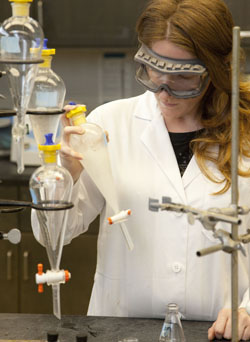Student studies role of clams in water decontamination
On the home page:
Click on the thumbnail to enlarge.
Junior chemistry major Caitlyn Guice and analytical chemist Phillip Voegel check the concentration of hydrocarbons in water collected from tanks containing clams. Her study attempts to determine if the clams can serve as natural cleaning systems for water contaminated by oil spills.
Dr. Phillip Voegel, Assistant Professor of Analytical and Environmental Chemistry
Caitlyn Guice, junior chemistry student, Prairieville
When the waters of the Gulf of Mexico were contaminated by the BP oil spill in the spring of 2010, Southeastern scientists and their students activated a plan to monitor water quality in lakes Pontchartrain and Maurepas. Their concern focused on the possibility of contamination from the spill spreading into the lakes that are so important to the area’s wildlife and seafood industry.
Analytical and environmental chemist Phillip Voegel and his undergraduate research assistant Caitlyn Guice studied water samples drawn from the lakes, as well as samples of the common Rangia clam. Fortunately, very little contamination from the spill impacted the area.
|
|
|
Caitlyn Guice
|
But their study sparked an idea with Guice. Since clams are bottom-dwelling filter feeders, they naturally draw in any contaminants. Could that natural feeding process actually work to decontaminate tainted waters with the clams serving as sponges absorbing oil or other chemicals?
The question led Guice with Voegel’s full encouragement and support to apply for and be awarded $2,500 in funding from the Louisiana Sea Grant Undergraduate Research Opportunities Program to study that process and determine the potential for clams to serve as a natural cleaning mechanism of waters polluted by oil or other contaminants.
“Looking at bioconcentration of hydrocarbons by shellfish in this manner is a complete shift in thinking from the typical focus on food safety,” said Voegel. “This project will provide new knowledge on the abilities of the clam to concentrate pollutants from the water and determine if and under what environmental conditions this ability could be applied to the bioremediation of oil-contaminated waters.”
Guice is looking at the effects of various environmental factors such as salinity levels in the water on the process of oil bioconcentration in clams. In the initial phases of the project, hexadecane, a hydrocarbon that served as a model compound for oil, was added to two aquariums in the laboratory: one with clams and one without to serve as a control. Water samples were to be collected daily and analyzed for hexadecane. In her initial lab experiments, hexadecane-contaminated water in a control tank with no clams remained cloudy with the pollutant, while the water in a tank containing clams was cleared within 24 hours.
“Because of the rapid removal of hydrocarbons by the clams, we’re now taking samples hourly to better gauge the rate of hydrocarbon removal by the clams,” she explained.
In addition to visual evidence, analysis of extracted water samples from the two tanks using gas chromatography/mass spectrometry clearly demonstrated decreased levels of hexadecane over time in the tank containing clams.
Her initial results were reported at the Basics of the Basin 2011 conference held on Southeastern’s campus and which attracted nearly 150 scientists and others interested in the research that is ongoing in the Lake Pontchartrain Basin.
A junior from Prairieville, Guice said the opportunities to do meaningful research as an undergraduate was what attracted her to Southeastern.
“I was able to start chemical research my second semester here, and I’m still researching under the same professor,” she said. “This has opened many doors for me.”
“There are many research opportunities in chemistry and physics for undergraduate students, and these opportunities lead to success after graduation,” Voegel commented.
Since 2008, all of Southeastern’s chemistry graduates that have participated in undergraduate research are currently working as chemists in industry or attending graduate or professional schools.
More Homepage Stories...


